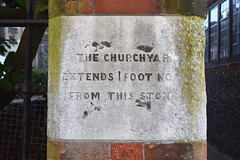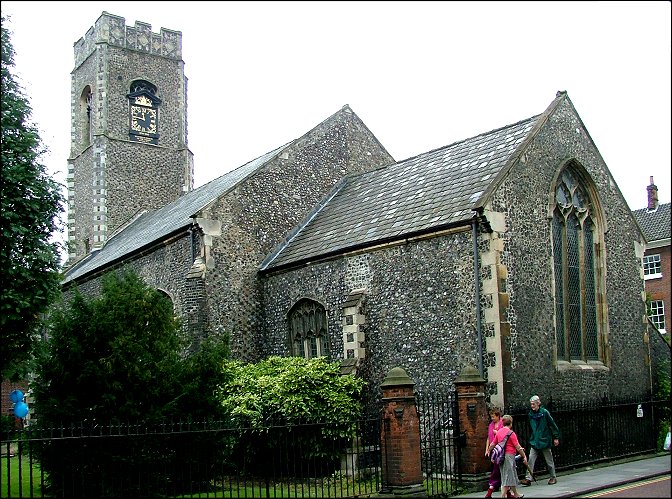| |
|
St
Clement Colegate, Norwich
 |
|
St
Clement stands at the point where medieval and
modern Norwich meet. To the south are Fye Bridge,
Tombland and the cathedral precincts, while to
the north is busy Magdalene street. Westwards
stretches Colegate, leading into Coslany, the
medieval Norwich-over-the-Water, the industrial
heart of the city in the 18th and 19th centuries.
Recent planning policies have brought residents
back into Coslany, but that was too late for St
Clement, which, along with half a dozen other
Colegate and Coslany churches, was declared
redundant as a result of the Brooke report in the
late 1960s. The clock was restored as a war
memorial, and looks very fine. Its placing over
the bell window is a bit awkward, but at least it
provides a landmark, and there isn't another
quite like it. St Clement was probably the
first of the city churches on the north side of
the river, and has lived through the changes that
a thousand years have brought. The present church
is almost entirely the work of the 15th century,
although the chancel is slightly earlier.
|
St
Clement's future was secured after redundancy in curious
circumstances. The lease was taken on by Jack Burton, a
local Methodist minister, on behalf of the Norwich
Transport Workers trade union, partly with the intention
of its use as a chapel. Because of this, all the internal
furnishings were retained. These, dating from the 19th
century, were from a time when St Clement's congregation
was almost wholly drawn from the local tenements and
slums that housed industrial workers, so this was
entirely appropriate. As it turned out, one man's
obsession had been a lifeline, and despite a later arson
attack, this was for many years the only one of Norwich's
redundant churches that was freely open to the public for
private prayer every day.
However, St Clement Colegate has now found a new, unusual
and rather wonderful use. In January 2017, Colin Howey
wrote to me: I am the Clerk of a stonemasons' craft
guild that has set up a lodge within St Clement Church.
We have been based here for around two years and are in
the process of training young people serving seven-year
terms to become stonemasons. In the final two years of
their apprenticeship they will go on their 'journey',
working itinerantly abroad, just as their Master did in
the early 1980s (we are connected with the German
Journeymen and French Compagnons). We currently have nine
apprentices training with us and will be recruiting a
further forty over the next decade.
Our
Master Mason is a City of London trained mason; an
international Guild Master (formerly Master at Windsor
Castle, Stoneleigh Abbey etc) and is one of the world's
leading craftsmen. His guild - the European Guild of
Master Masons - was founded in 1096 and has been in
continuous existence ever since (being European in scope
they survived intact by moving around when conditions -
English Reformation/French Revolution etc - required it).
There are only twelve Guild Masters in the world.
Upon
re-founding a craft guild in Norwich, in recognition of
his immense contribution to St Clement, we asked the
Reverend Jack Burton to be our Prime Warden - a request
he duly accepted. Being a guild in livery we undertake
quarterly processions and perform our Mystery Play - Cain
and Abel - in the city during Corpus Christi. We also
have an Artist in Residence working with us and a guild
storyteller - the 'Gleeman'.
Coming
back in May 2017, I stepped through the stonemasons'
yard, past guild banners, into the church through the
south porch. It was a good twelve years since my last
visit, but it was clear that the interior had undergone a
great transformation. The church is full of colour, guild
banners hanging from the roof and around the walls. The
west end of the nave has become the masons' study area,
arrayed with display cases showing examples of different
stones and techniques, as well as stacks of books. Beyond
to the east is a design working area. The chancel is
maintained as the guild chapel. The furnishings and font
remain in situ. The font is an early 16th century one,
with that proto-renaissance styling that makes us wonder
how artistic endeavour might have flowered if the
Reformation had not intervened.
| There
is also a 1516 figure brass to Margaret Petwood
in the middle of the nave, and these two features
may indicate the date at which the church was
finished. Lady Margaret stands with a large
rosary belt wrapped around her middle, a
declaration of theological intent in those days
immediately before the protestant reformation. A
curiosity is that her brass appears to be inlaid
with a slightly different coloured latten. Was it
repaired at some point, or was that the original
intended effect? There are 18th and 19th
century memorials around the walls to the Ives
and Harvey families, who supplied a number of
mayors of Norwich. Despite the change in use,
there is still a sense of the church's 19th and
early 20th Century integrity. Even the cradle
roll survives on the north wall. A number of
Norwich's redundant churches have found new uses
in the early years of the 21st Century, but I
felt that out of all of them this was the one
which was at once the most significant and the
most sustainable.
|
|
 |
Simon Knott, January 2018
|
|
|

